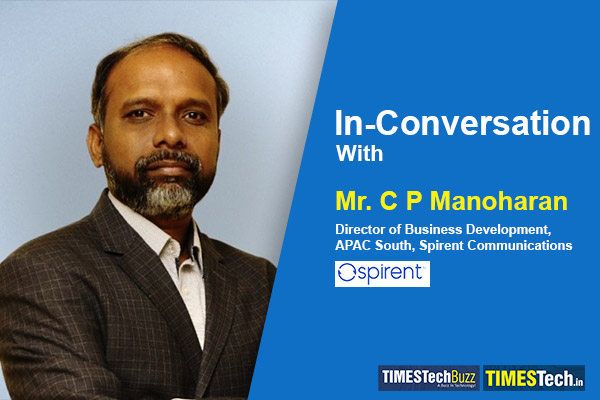In an exclusive interview with TimesTech, C P Manoharan, Director of Business Development, APAC South at Spirent Communications, emphasizes the significance of end-to-end testing in the evolving landscape of network operations. From navigating the complexities of cybersecurity to addressing multi-vendor interoperability challenges in Open RAN and facilitating the integration of security into 5G deployments, Spirent’s innovative solutions play a pivotal role in ensuring the resilience, security, and performance of modern networks.
Read the full interview here:
TimesTech: Why end-to-end testing is vital for network operations teams? How do Spirent solutions help?
Mr. Manoharan: With the introduction of disaggregation, edge computing, cloud-native architecture, and multi-vendor environments, today’s networks are much more complex. Enterprises require agility, security and end-to-end visibility of live networks and services; so that problems can be detected and resolved before customers are impacted. To navigate in this complex next-generation network ecosystem, and maximize the resiliency of networks—enterprises must be able to rapidly validate before going live. For an enterprise customer, it is crucial to gain visibility, agility and flexibility with unified validation approach. To facilitate overall orchestration, essential testing practices helps ensure what is planned gets deployed on-time, under budget and with expected performance levels, ultimately ensuring consistent user quality of experience.
Manufacturing and BFSI enterprises must have a strong and comprehensive assessment and validation strategy to maintain security, performance, and access in current architectures. To succeed in today’s complex environment, enterprises need to perform realistic tests before going live. Once live they need end-to-end visibility and automation across the lifecycle. The strategy should be supported by deep domain knowledge & expertise to break the network down into components with a detailed understanding of what testing approach provides the most comprehensive solution, to deal with the complexity of all these domains.
As a leading global provider of test and assurance solutions, Spirent’s innovative portfolio of products and services addresses the test, assurance, and automation challenges of an entire new generation of technologies: High-speed Ethernet, 5G, Wi-Fi 7, SD-WAN, cloud, cybersecurity, positioning, autonomous vehicles and beyond. Spirent is at every step of the technology lifecycle from lab validation to field acceptance and assurance in the real world, creating a collaborative development environment enabling enterprises, network operators and NEMs, to achieve agility, reduce risk and costs, simplify complexity and accelerate time to market.
TimesTech: To navigate through the complexities of cybersecurity, how can enterprises validate that network services are secure? How do Spirent solutions help enterprises?
Mr. Manoharan: Enterprise networks are undergoing an unprecedented transformation and investment in cyber-resilience remains high. As enterprises deploy new technology and applications to a range of devices, IT teams are pressurised to manage more devices, varied types of connectivity, advanced applications and highly complex platforms. New technologies such as; cloud, SD-WAN, Wi-Fi 6 and 5G bring the promise of faster, more efficient networks and applications, at the same time bring increased complexity and introduce new security vulnerabilities. Performing regular assessment and validation enables organizations to minimize the risk of downtime and proactively address the increasing onslaught of security vulnerabilities.
Typical pre-deployment scenarios are simple and mostly dependent on system integrator’s data or product datasheets: devices connected directly to data centres or clouds under ideal conditions with minimal traffic on the network. Once the new equipment goes live, problems occur as load increases, leading to impaired experiences and high costs. Lack of visibility of all parts of the network limits IT team’s ability to find problems before they become major issues. The root cause of the visibility issue is typically related to the use of vendor-specific monitoring systems and the inability to measure the end-user’s true experience at end points.
The following essential testing practices are recommended to ensure new network technology performs and deliver the performance customers demand:
- Performance validation to measure everything from voice quality to packet jitter – all the factors necessary to understand end-user experience and isolate and resolve problems
- Network emulation to mimic real networks, devices and users including heavy traffic loads
- Network impairment incorporated alongside emulation to precisely assess how networks will respond to real-world faults or degradations
- Security assessments to proactively detect vulnerabilities so security weaknesses can be addressed before they’re exploited
- Test-bed automation for rapidly expediting complex testing scenarios and maximizing equipment use with optimal sharing of resources
Investing in a robust network infrastructure and performing regular assessment and validation enables organizations to minimize the risk of downtime and proactively addresses the increasing onslaught of security vulnerabilities. In addition, the enterprise network has to be met with the regulatory & security compliance assessment periodically. Test lab modernization and CyberThreat Assessment (CF CTA) evasion tools emulates a wide range of hyper realistic hacker behaviour, including encrypted attacks & evasion techniques and automates IT network and security testing, reducing costs, while improving productivity.
Spirent provides cybersecurity expertise to customers across a broad range of industries. These varied businesses include: financial institutions and stock exchanges, technology enterprises, network equipment manufacturers, petroleum, education, media, global navigation satellite systems, aircraft and automotive manufacturers, as well as telecommunications and wireless service providers.
TimesTech: Open environment creates a new set of challenges, mainly multi-vendor interoperability. How can CSPs address the testing challenges of Open RAN?
Mr. Manoharan: Open RAN has the potential to usher in new use cases and innovation while lowering costs only if its performance and business model deliver as promised. To ensure its potential is met, it is important to validate the components of Open RAN’s multi-vendor, plug-and-play architecture for interoperability and end-to-end performance before deployment in the live network.
Spirent’s Open RAN test solutions deliver the performance and flexibility required to support evolving O-RAN technologies. The solutions help CSPs and NEMs offer the best possible user experience with the highest levels of assurance that their networks and devices are ready for commercial rollout with optimal performance to drive business outcomes.
As a vendor-neutral test expert, Spirent partners with customers to overcome Open RAN’s unprecedented complexity with solutions that streamline and automate validation workflows.
• Single user experience: Spirent’s O-RAN solutions integrate an ever-expanding set of test system components and instruments into a single user interface designed explicitly for O-RAN test cases, radically accelerating testing.
• Automation: A multi-vendor Open RAN brings an order of magnitude increase in the number and frequency of validation tests required and the complexity of the test environment. Spirent’s approach leverages single user interface to automate test workflows, making it possible to keep up with Open RAN’s radically expanded set of multi-vendor releases.
• End-to-end emulation: Open RAN testing requires a comprehensive set of emulation capabilities covering the entire end-to-end network from UE, RF channel and 5G core emulation, to RU, DU, CU, and RIC emulation. Spirent incorporates all these emulation capabilities into a unified portfolio of solutions for performing nodal, adjacent, and full system testing of Open RAN functions.
• Test as a Service model: The complexity of Open RAN and the high-performing 5G network in which it resides beckon for new, automated testing methodologies that continuously validate real-world performance and robustness, ensure interoperability, collaboration, and open ecosystems, and realize cost efficiencies and innovation benefits. Spirent’s Test as a Service solution covers management, execution and automation of a CI/CD pipeline with automated validation testing of 5G CNFs and network functions virtualization infrastructure (NFVI).
TimesTech: 5G is on its way to consumers and enterprises. How is Spirent helping NEMs and CSPs integrating security into 5G deployments?
Mr. Manoharan: 5G represents a fundamental disaggregation of the network, opening areas of vulnerabilities susceptible to exploits or malicious activity. As cybersecurity threats keep changing, new security vulnerabilities must be secured to support the mission-critical use cases being promised by 5G. NEMs and CSPs need trusted guidance on how to integrate security into 5G deployments, continuously assess the effectiveness of the security they’ve put in place, and how to focus on innovation rather than risk.
A well-designed 5G security testing strategy should address wide range of needs across numerous dimensions. Recognizing the magnitude of vulnerabilities, any comprehensive 5G cybersecurity testing strategy must be aimed at ensuring the security of modern complex 5G infrastructures. This should incorporate security analysis and testing at different layers, including hardware, firmware, operating system, middleware, application and protocol stacks (e.g., signaling and control plane).
Spirent offers a broad range of capabilities and solutions that facilitate 5G security testing, auditing, supplier certification, and validation, including:
Continuous Assessment and Validation solutions:
• VisionWorks: A rugged virtual test platform that emulates realistic user activity to proactively test 5G networks and services.
• CyberFlood Data Breach Assessment: Delivers accurate, automated, continuous and thorough assessment of live 5G production network environments, using an always-up-to-date database of hyper-realistic attack, malware, data loss prevention, and applications scenarios.
Automated test tools and emulators:
• CyberFlood: A testing platform that generates realistic application traffic and attacks to test the performance, scalability and security of 5G infrastructures.
• 5G Digital Twin: A new agile, automated approach to testing and assurance providing an emulated, software replica of the 5G physical network.
Consultancy and test services:
• SecurityLabs: Provides comprehensive scanning, penetration testing, and monitoring of 5G networks, applications, devices and endpoints.
• Test-as-a-Service: Offers continuous supplier validation as a managed service and allows CSPs to run through future risks and mitigations.
For a Tier 1 US operator, to achieve a new level of agility and meet its lab validation needs spanning access, core and cloud domains, Spirent constructed a Test as a Service (TaaS) solution from multiple lab-to-live testing capabilities: This included: synthetic traffic generation consisting of 5G signaling and userdata, cloud infrastructure impairments, and application traffic, network & attack emulation comprised of 5G core and access networks, cloud-native functions and security attackers and automation including pre-defined validation test libraries and CI/CD/CS integration services.
TimesTech: Operators see opportunity in providing 5G private networks to large enterprises. What are the current trends driving private 5G networks?
Mr. Manoharan: Private 5G networks are emerging as an innovative solution to address critical wireless communication requirements for use by enterprises in multiple industries, such as manufacturing, academics and utilities. The roll-out of 5G, growing availability of edge computing, and enhanced automation offers enterprises of all sizes, the prospect of unprecedented agility and control through private networks. The ability to tailor the network to specific application environments offers a compelling value proposition.
However, technologies (e.g., 5G, 4G/LTE, Wi-Fi, etc.), deployment models, commercial models, and vendors, necessitate a rethinking of service-level management and the testing strategies required to achieve these new capabilities. Enterprises must enforce not only performance KPIs, but availability and security as well. One of the most pressing needs is to test and validate that all the infrastructure and functions of the largely software-based architecture can work together as intended with compliance to 3GPP standards.















